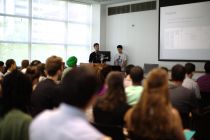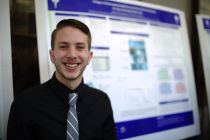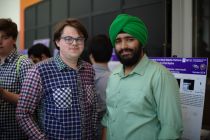Summer Vacation in the Lab
Students Willingly Hit the Lab Bench instead of the Beach Towel at the NYU Polytechnic School of Engineering
No one would deny that attending an engineering school is a rigorous endeavor requiring copious amounts of hard work and study. Once the summer finally arrives, most students might be happy to just relax and recharge near the ocean, in the woods, at some exotic foreign destination, or simply on a patch of grass in a city park.
But for some students, nothing can beat the excitement of being in the lab, working on a cutting-edge research project with a faculty mentor. Those students, as the saying goes, eat, sleep, and breathe research. (And we should add that they vacation with it too.)
 For almost a decade, the NYU Polytechnic School of Engineering’s Undergraduate Summer Research Program—an initiative overseen by Associate Dean of Undergraduate Academics Iraj Kalkhoran—has provided a unique opportunity for School of Engineering and other NYU students to work alongside faculty mentors for 10 weeks, enhancing and broadening their knowledge base and discovering practical solutions to pressing scientific challenges.
For almost a decade, the NYU Polytechnic School of Engineering’s Undergraduate Summer Research Program—an initiative overseen by Associate Dean of Undergraduate Academics Iraj Kalkhoran—has provided a unique opportunity for School of Engineering and other NYU students to work alongside faculty mentors for 10 weeks, enhancing and broadening their knowledge base and discovering practical solutions to pressing scientific challenges.
This summer, for the first time, young NYU researchers were joined by their contemporaries from around the globe, as School of Engineering faculty members opened their labs and lent their support to students from such institutions as Johns Hopkins, Stockholm’s KTH Royal Institute of Technology, the University of Massachusetts, and the Universidad de Puerto Rico en Río Piedras.
 The students presented their research findings on August 7, and all were in high spirits, excited to share what they had learned; it seemed that for these aspiring scientists and engineers, 10 extra weeks in the lab had been the best adventure imaginable.
The students presented their research findings on August 7, and all were in high spirits, excited to share what they had learned; it seemed that for these aspiring scientists and engineers, 10 extra weeks in the lab had been the best adventure imaginable.
Below are a few highlights.
- Microprocessor-Based Digital System Design
- Chemical Shift and Stereoelectronic Effects
- Nonphotochemical Laser Induced Nucleation of Supersaturated Glycine Solutions in Agarose
- Automated Microfluidic Detection of Contaminants in Colloidal Suspension
- Lightweight Magnesium Matrix Composites for Automotive Applications
Microprocessor-Based Digital System Design
Joseph Bieselin, who is earning a bachelor’s degree in computer engineering along with a master’s in computer science, wants to change the way his fellow students choose design projects. “Designing a project using hardware requires a greater depth of knowledge than needed for software because software development tools have matured rapidly, allowing people to easily pick up new technologies,” he explains, bemoaning the fact that design tools for hardware are rarely user-friendly or intuitive.
He and his lab partner, Steven Wong, have been working on a solution: Reconfigurable chips known as field programmable gate array (FPGA) chips can provide hardware programmability and speed, and employing them in conjunction a graphical user interface (GUI) could encourage others to become more interested in hardware development and lead to them being eager to use FPGAs after graduation. “The reasoning behind using the FPGA is that the application runs on hardware,” Bieselin elaborates. “And because there is no software involved, it runs much faster."
To that end, under the supervision of Professor Haldun Hadimioglu, they are creating adaptations of the game Pong that run completely on an FPGA board and are displayed on a full-size computer monitor, as well as a number-based game that originally ran only on hardware.
Chemical Shift and Stereoelectronic Effects
Alex Chew has not yet decided which path he will pursue after he earns his combined bachelor’s degree in chemical and biomolecular engineering and master’s in chemical engineering in 2016, but a post in academia is a distinct possibility. Exhibiting the exceptional patience that is a hallmark of a natural teacher, he explained to the laypeople attending the Summer Research presentation on August 7 just what chemists mean when they refer to chemical shift and why it is important.
Working with Professor Abhijit Mitra, Chew had spent the summer computationally modeling chemical shift—the resonant frequency of nuclei relative to a standard, which can give clues about a molecule’s structure—using specialized software called Gaussian 09 and other tools.
“I know my work sounds very theoretical but understanding chemical shift can give us insight into the electronic environment around a nucleus that we can then apply to other molecules and systems,” he says. “It’s like solving a mystery, so you have to pay attention; some motifs and clues come up again and again.”
Nonphotochemical Laser Induced Nucleation of Supersaturated Glycine Solutions in Agarose
Audrey Goh begins explaining her summer’s work with a history lesson: It was a professor in Edinburgh, she says, who discovered that dissolving a supersaturated potassium chloride solution in agarose gel (a substance used by scientists when they sort large molecules by size and electrical charge) and exposing it to laser light would allow him to control the process of crystallization.
 Crystallization is generally wildly random, she explains, liable to be affected by small fluctuations in temperature, pressure, and purity of solution. “We now know that by using agarose gel that we can control where the crystals grow and exactly how the molecules are oriented.”
Crystallization is generally wildly random, she explains, liable to be affected by small fluctuations in temperature, pressure, and purity of solution. “We now know that by using agarose gel that we can control where the crystals grow and exactly how the molecules are oriented.”
Under the direction of Professors Bruce Garetz and Janice Aber, Goh is experimenting with glycine gels, most of which instantly began to crystallize when exposed to a laser. (The crystal growth began at the air/gel surface with thin, feathery branches that extended downward—an unusual morphology she had not expected to see.)
Controlling crystallization has many industrial applications, she explains, and she expects to investigate further before completing her bachelor’s degree in biomolecular science and master’s in chemistry in 2016.
Automated Microfluidic Detection of Contaminants in Colloidal Suspension
Finding contaminants in suspension will always be an exceptionally important task, Katarzyna Somszor explains, since the entire world needs clean water. Furthermore, the transport of particles is important not only for water desalination and filtration but in biological systems like blood flow.
 Somszor, a native of Poland who transferred to the NYU School of Engineering from Warsaw Polytechnic, is working with another recent arrival, Professor Emilie Dressaire, who joined the faculty last year and who studies particles, interfaces and fluids in the newly appointed Particles, Interfaces and Fluids Lab. “Professor Dressaire is a wonderful mentor,” Somszor asserts. “She is fully supportive of me and devoted to my growth as a student and researcher.”
Somszor, a native of Poland who transferred to the NYU School of Engineering from Warsaw Polytechnic, is working with another recent arrival, Professor Emilie Dressaire, who joined the faculty last year and who studies particles, interfaces and fluids in the newly appointed Particles, Interfaces and Fluids Lab. “Professor Dressaire is a wonderful mentor,” Somszor asserts. “She is fully supportive of me and devoted to my growth as a student and researcher.”
The two are using microfluidic porous membranes to detect and remove contaminants suspended in a fluid, and Somszor explains, “Once a clog of contamination is formed, incoming particles aggregate upstream, and the aggregate builds over time, leading to a dramatic increase in hydraulic resistance. We’re proposing a new experimental method to automatically detect clog formation based on levels of pressure. Because a microscope won’t be needed, we’ll have eliminated a step and will be closer to a fully automated system that could one day be patented and commercialized.”
Somszor, who expects to receive her bachelor’s degree in chemical and biomolecular engineering in 2017, is grateful for the opportunity to work on such an important project despite still being an undergraduate. “I’m getting the opportunity to do real hands-on work here in the U.S., thanks to NYU and Professor Dressaire,” she says.
Lightweight Magnesium Matrix Composites for Automotive Applications
The push for the auto industry to achieve higher fuel efficiency and reduced carbon emissions is steadily increasing. As Steven Zeltmann, a combined bachelor’s-master’s candidate who expects to earn his degrees in mechanical engineering in 2017, explains, however, those goals most certainly won’t be met without the use of lightweight materials in the structures and load-bearing components of vehicles. Working with Professor Nikhil Gupta, he is investigating the use of magnesium alloy composites reinforced with particles of silicon carbide (SiC).
 Zeltmann is helping to use a novel process to produce the small spheres of SiC, as well as a fabric of SiC fibers. Because the spheres are hollow, a small quantity of air is entrapped to create a reinforced material known as “syntactic foam.” A single sphere’s shell can reportedly withstand pressure of over 25,000 pounds per square inch before it ruptures—one hundred times the maximum pressure in a fire hose. The hollow particles also offer impact protection to the syntactic foam because each shell acts as an energy absorber during its fracture. The composite can be customized for density and other properties by adding more or fewer shells into the metal matrix to fit the requirements of the application, making the material a possible boon to auto manufacturing and other industries.
Zeltmann is helping to use a novel process to produce the small spheres of SiC, as well as a fabric of SiC fibers. Because the spheres are hollow, a small quantity of air is entrapped to create a reinforced material known as “syntactic foam.” A single sphere’s shell can reportedly withstand pressure of over 25,000 pounds per square inch before it ruptures—one hundred times the maximum pressure in a fire hose. The hollow particles also offer impact protection to the syntactic foam because each shell acts as an energy absorber during its fracture. The composite can be customized for density and other properties by adding more or fewer shells into the metal matrix to fit the requirements of the application, making the material a possible boon to auto manufacturing and other industries.
Zeltmann says that the really exciting thing about materials science is “how much we don't know: how many innovative products nobody has stumbled upon yet.” With his focus on work and research, even during the summer, there seems like a good chance that he’ll be one of those doing the discovering.





